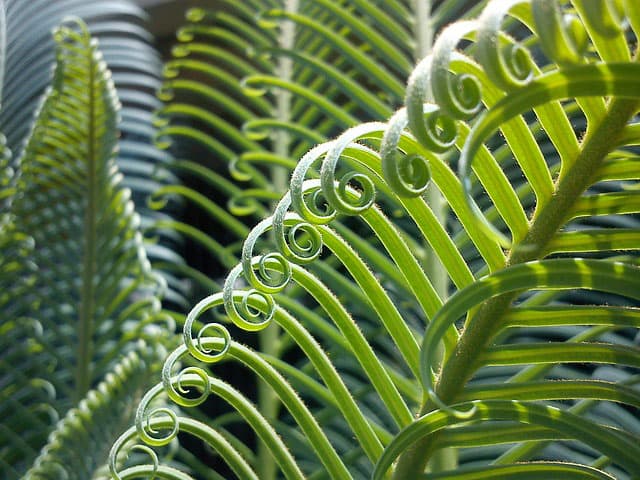PLANTING AND PROPAGATION OF FERN
- Division/Fragmentation
- Spore
propagation
- Tissue
culture
Division/Fragmentation
Rhizome
à batang beserta
bagian-bagiannya (sisik/rambut) yang menjalar di dalam/atas tanah
Division/Fragmentation
Most pteridophytes with creeping rhizomes are easily propagated
vegetatively by division of rhizomes branches
The divison should have an active growing tip which can be recognized by
the fresh colour and the young leaves arising at short distances behind the
tips
Division/Fragmentation
The development of growing tips from side buds on thick rhizomes may be
stimulated by partly cutting through the buds.
All cuts should be made with a sharp and clean knife.
Care must be taken not to injure the growing tips and to keep as much
soil to the roots as possible but damaged leaves and old roots should be
removed
Division/Fragmentation
•
The cuttings should be planted as deep in the soil as
it was before or slightly deeper if the roots remain uncovered.
•
If the cuttings does not bear roots it may be placed
half of its diameter within the soil and secured with benth wire or length
allowing diagonally with the growing tip emerging from the soil.
Division/Fragmentation
•
The divisions should be kept moist, but not wet, and
in light but not exposed to the sun.
•
To keep the relative humidity high, thin-leaved
species may require glass or plastic sheet covering which can gradually be
removed when the plants grow up.
•
Inorganic fertilizer is applied after 15-20 days but
organic fertilizer shoul be avoided at this early stage as bacteria and fungi
it contains may turn against the vulnerable explants.
Fern Propagation
Some species produce vegetative reproduction organs such as runners,
bulbils or even buds developing into young plantlets whilst still attached to
the parent leaves.
Fern Propagation
•
When available these organs are better suited for
vegetative reproduction than rhizomes divisions.
•
To reduce the risks during their early life stages,
the organs are left to root and to grow
well before detaching them, allowing the to profit from nutrients and water
supplied by the parent plant.
Spore Propagation
Spora
à Pelepasan dan
penyebaran spora paku sangat unik.
à Sporangium pecah dan
membuka spora terlepas.
à Dalam keadaan lingkungan
yang sesuai, spora menyerap air sehingga dindingnya pecah dan kemudian
berkecambah serta membentuk protalus (protonema).
Spore Propagation
•
Ferns are reproduced from spores that are gathered in
clusters called sori, which are usually on the underside of the fronds.
•
The spores can be yellow, green, brown, or black.
•
The sori are sometimes covered with a membrane called
an indusium, which will lift up when the spores are ripe.
•
In the Pacific Northwest, spores ripen from late May
through October and will waft off like fine dust.
•
To collect spores place a portion of mature frond on a
piece of paper in a dry place.
•
To gather the spores, pick a frond or portion of a
frond and place it between two sheets of white paper.
•
If ripe, the spores should drop within 24 hours and
will leave a pattern on the paper.
•
They will also be shed onto the paper and will appear
as black, brown or yellow 'powder' which is a mixture of spores and fragments
of the spore cases (sporangia).
•
The spores are then ready to be sown.
•
The spores are dusted on the top of the mix and the
lid put on the container, which is then placed under cool white fluorescent
lights that are turned on for 14 hours a day.
•
The spores must be out of direct sunlight.
Spore Propagation
•
It is important to sterilise the germination mixture
before sowing the fern spores by pouring boiling water over it.
•
This kills the spores of fungi and other plants that
may germinate and crowd out the developing fern prothalli.
•
Spores should be sparsely sprinkled on a medium such
as finely chopped tree fern fibre, peat moss or sphagnum moss.
Spore Propagation
•
Equal parts of loam, peat moss and finely crushed
terracotta spread to a depth of 2 cm over a base of vermiculite also forms an
excellent germination base.
•
Once sown the containers should be covered with
plastic or glass (allowing some airspace) and kept at around 20 degrees C in
indirect light.
•
Spores take from 2 to 6 weeks to germinate.
Spore Propagation
•
In time perhaps as soon as several weeks a thin, green
haze will form on the mix.
•
This will grow into a carpet of prothallia, which are
small, green, heart-shaped structures and contain the sperm and the egg.
Spore Propagation
•
When the prothallia are approximately ¼ inch, they
should be lightly misted to hasten fertilization.
•
If no little sporelings appear in several weeks, mist
again.
•
They are then transplanted into pots, and finally
moved out of doors when they are four to six inches tall depending, of course,
on the season.
Spore Propagation
•
After a few weeks the germinating spores appear as a
mossy growth.
•
When the prothalli are formed and well developed they
may be pricked off into a punnet containing a finely sifted soil mixture.
•
The container should be covered with glass or plastic
until the fronds appear. The developing ferns should not be exposed to direct
light.
Spore Propagation
•
Further potting up should be into a coarser textured
mix with relatively high levels of organic matter. The mix should drain well.
•
Materials such as sharp river sand and gravel-sized
charcoal pieces may be useful for this purpose.
Teknik Persemaian Spora
1. Menyiapkan Media 2.
Menabur Spora
3. Pemisahan Bibit Muda 4. Pembesaran
Bibit
Perbanyakan dan Penanaman Beberapa Tumbuhan Paku
Budidaya paku Lycopodium sp.
a. Pemeliharaan dan perawatan
Modifikasi kondisi lingkungan
Media tanam
Pemupukan
Cahaya
b. Pemanenan
dipanen dalam bentuk
potongan untaian batang dan tanaman dalam pot
c. Hasil
à Tanaman hias pot à pot
gantung/sebagai salah satu ornamen landscape
d. Penanganan pasca panen
Dikeringkan dan
disimpan dalam kondisi suhu rendah dan kering
Budidaya Suplir (Adiantum sp.)
- Pembuatan
Media Tanam.
- Pemeliharaan.
- menanam,
menyiram, memupuk, menjaga lingkungan dan penggantian pot.
c. Perbanyakan.
- perbanyakan
vegetatif dan perbanyakan generatif
Tissue Culture
•
A technically more advanced means of vegetative
propagation is tissue culture (also meristem culture) which allows for mass
multiplication under well-controlled conditions, though starting with tiny bits
parent material.
Tissue Culture
For commercial use, this
technique offers significant advantages :
the product is free of diseases,
the quality is high and constant,
the application is not dependent on parent plants to form spores and,
it much faster
•
To start, apical meristems are taken from parent
plants.
•
The meristems consist of actively dividing cells that
are not yet infected by germs.
•
They are cleaned and externally sterilized and then
transferred to a sterile, often fluid growing medium where they are kept under
controlled conditions for several weeks to let them start multiplying by
dividing.
Tissue Culture
•
Part of the produced cell-clumps is explanted to a
solid artificial growing medium to grow young plantlets, while the rest is kept
in stock for a new production cycle.
•
Many variations in medium composition and treatments
(ex : plant hormones) exist to stimulate the growth of the meristems and the
development into plantlets.
Fern harvesting and handling after harvest
•
For ornamental use, Adiantum plants grown from spores can be
traded about one year after sowing.
•
Plants part are harvested in the growing season
whenever needed for medicinal uses.
•
For medicinal uses, harvested leaves and rhizomes can
be dried and stored.
Fern harvesting and handling after harvest
•
The easiest way to collect Azolla pinnata on
the surface of the water is by using nets and transports in big baskets.
•
To mix dried Azolla as food supplement for
pigs, chickens, ducks, fish, et al the freshly harvested Azolla is dried
in the sun for 3-7 days.
Fern harvesting and handling after harvest
•
Lycopodium cernuum (used for medicinal uses ex
: to treat fever, asthma, beri-beri) is harvested from wild populations when
needed.
•
Fresh stems and branches are tied up into bundles and
brought to the market for sale.
Fern harvesting and handling after harvest
•
All used parts of Lygodium are harvested
whenever needed.
•
Entire plant parts can be stored for 6 years in drying
condition at room temperature, had
retained at least part of their antibiotic activity.
Fern harvesting and handling after harvest
•
Marsilea crenata is harvested from wild at
the beginning of the rainy season.
•
When cultivated, the first young can be harvested
after 3 months after planting.
•
The leaves are cleaned thoroughly and sold tied in
bundles.
Fern harvesting and handling after harvest
•
Selliguea feei is harvested from the wild
when the need of medicinal purposes arises.
•
The rhizomes can be extracted to prepare
pharmaceutical preparations.
•
The returns are 19-20 % of the raw materials.
Fern harvesting and handling after harvest
- Freshly
harvested leaves of Nephrolepis cordifolia (without sporangia)
placed in water for 10-20 hours at 2-40C can be stored in
perforated plastic film for 14 days.




















